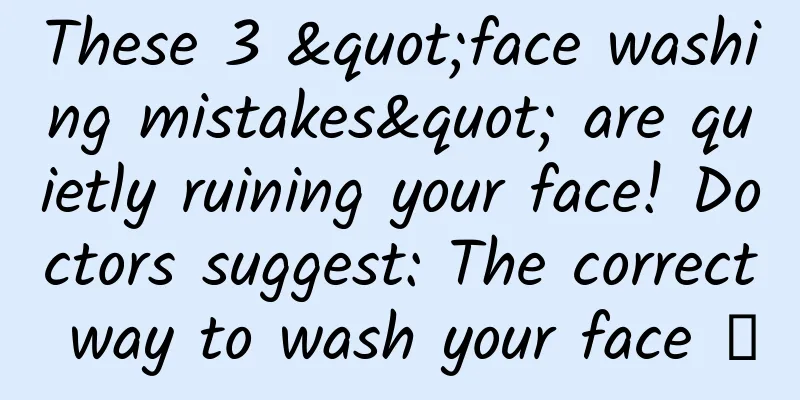These 3 "face washing mistakes" are quietly ruining your face! Doctors suggest: The correct way to wash your face →

|
November 7th of each year is World Beauty Day, which aims to promote people's understanding of beauty issues and mobilize people to support the development of beauty. Speaking of beauty, you may think of many medical beauty projects, but today we will talk about the most cost-effective beauty method - cleansing . Image source: Pexel Have you fallen into these 3 facial cleansing misunderstandings? Myth 1: Facial skin needs "deep cleansing" Whether it is the beauty industry, the lifestyle beauty industry or the medical beauty industry, they are all obsessed with the concept of "deep", such as deep hydration, deep anti-aging, etc. Deep cleansing is also one of the well-known concepts. But it happens that the face does not need "deep cleansing". Due to the existence of the skin barrier on the surface of the skin, no matter what kind of cleansing ingredients are used, they will ultimately just "wash" the surface of the skin and take away dirt and grease. However, due to different cleaning abilities, the cleaning effects produced are not the same, and the skin feel of the product will also be different. Conventional "deep cleansing" cleansing products are generally formulated with soap or SLS/SLES as the main cleansing ingredients. Due to their strong cleansing ability, the skin is usually very dry or even tight after use, creating a feeling of being thoroughly cleansed, giving users a "deep cleansing" experience. How to identify soap-based cleansers: Soap base is produced by the reaction of fatty acids and strong alkali. Therefore, if one or more fatty acids and alkali agents appear at the same time in the ingredient list, we can preliminarily determine that this may be a soap-based cleanser. Fatty acids commonly used in soap-based cleansers: myristic acid, stearic acid, lauric acid, palmitic acid, etc. Commonly used alkali agents: sodium hydroxide, potassium hydroxide, triethanolamine, etc. In addition, some ingredient lists may directly list the soap bases generated by the above fatty acids and bases, such as: sodium/potassium/triethanolamine salt, sodium/potassium/stearate/triethanolamine salt, sodium/potassium/laurate/triethanolamine salt, sodium/potassium/palmitate/triethanolamine salt, etc. Methods to identify SLS and SLES: The full name of SLS is Sodium Lauryl Sulfate . The full name of SLES is Sodium Laureth Sulfate . Both are very powerful surfactants, and if you find them on the ingredient list, then this product is an SLS/SLES cleanser. Since long-term use of such products may cause increased skin moisture loss, damage to skin barrier function, and even affect the thickness of the stratum corneum and other problems, it is generally not recommended for normal dry skin, dry and sensitive skin, oily and sensitive skin, or even neutral skin. However, for people with rapid oil secretion and non-sensitive skin, using them as daily skin care products in the medium to short term can bring a drier feeling and make the skin more comfortable. This is why soap and perfumed soaps are also mainly composed of soap bases. Many men with oily and non-sensitive skin wash from head to toe with soap and perfumed soap and feel very comfortable, but many women with dry and sensitive skin cannot stand it. Although not all men and women are like this, it is indeed the result of the physiological differences between men and women. Myth 2: Amino acid cleansers must contain amino acids With the implementation of the new national "Regulations on Cosmetic Label Management", only cleansers with added amino acid ingredients can be called amino acid cleansers. However, in the skin care industry, the amino acid cleansers generally refer to cleansers with added amino acid surfactants, so the more accurate name for this type of product should be amino acid surfactant cleansers . Image source: unsplash.com For most normal dry skin, dry sensitive skin, oily sensitive skin and even neutral skin, it is recommended to use amino acid surfactant cleansers, because the overall cleaning power of this type of surfactant is relatively mild, has little effect on the skin barrier function, and is more suitable for long-term use. Adding amino acids to cleansers is a common practice in many cleansing products, including soap-based cleansers and SLS cleansers. Since amino acids have a moisturizing effect, adding them to the formula can increase the moisturizing level of the skin and reduce the tightness caused by strong cleansing with soap-based, SLS and other ingredients. In terms of efficacy, the two cannot be confused. Methods for identifying amino acid surfactants: The names of the most commonly used amino acid surfactants can be divided into three parts: Acyl group + amino acid + sodium/potassium For example: sodium cocoyl glutamate, disodium cocoyl glutamate, sodium cocoyl glycinate, potassium cocoyl glycinate, sodium lauroyl glutamate, etc. Myth 3: The more bubbles a cleanser produces, the better First of all, the cleaning power of facial cleansers does not depend on the amount of bubbles, and this concept may be formed and reinforced mainly due to the impression left by people through years of advertising. The actual cleaning power of facial cleansers depends on the addition of soap base or other surfactants that are mainly responsible for cleaning in the formula. Secondly, the substances responsible for foaming are still surfactants, which can indeed add a certain cleaning power in addition to the main cleaning ingredients. For ordinary dry skin or dry and sensitive skin, this may further aggravate the feeling of tightness and dryness. Therefore, many cleansing products suitable for sensitive skin, especially those suitable for extremely sensitive skin, usually produce very little foam, or even almost no noticeable foam, but this does not mean that the products cannot clean the face. Image source: Pexel To determine whether a product is suitable for you, you don’t need to look at the amount of bubbles or whether the bubbles are dense, but the skin feel after use. If your skin is not dry or tight and your face is smooth after cleansing, then this product may be suitable for you . Of course, although bubbles are not necessary, for people who have extra demands for user experience, dense bubbles and comfortable feel are extra plus points in addition to the above standards. Do these 4 points and master the correct cleansing method After reading this, do you know how to choose a facial cleanser that’s right for you? Then how should you wash your face correctly? Based on the Chinese Skin Cleansing Guide, I have summarized the following 4 suggestions to help you cleanse your face scientifically: 1. Cleansing frequency: It is recommended to clean once every morning and evening. 2. Facial cleansing products: It is not necessary to use facial cleansing products every time you cleanse. All types of skin can use only water or a combination of water and facial cleansing products to cleanse according to their skin feelings. However, if the temperature is hot, the working and living environment is poor, sunscreen or powdery or oily cosmetics are used, or there are other special circumstances, it is recommended to use facial cleansing products. 3. Water temperature for cleansing: It should be warm enough for the skin to feel. Too cold water may not be able to cleanse well, and too hot water may damage the skin barrier. 4. Post-cleansing care: Regardless of skin type and whether or not you use cleansing products, you should use moisturizers after cleansing to ensure healthy hydration of the skin. Oily skin or skin that produces oil quickly can choose light moisturizing lotions, moisturizing gels and other products; less oily skin or dry skin needs to use relatively moisturizing lotions and moisturizing creams; sensitive skin may also need to use moisturizing products that have a certain skin barrier repair function, are hypoallergenic, and are fragrance-free. Planning and production Author: Dr. Zeng Xiangru, dermatologist Review | Feng Jun, Deputy Chief Physician, Dermatology Department, General Hospital of Datong Coal Mine Group Co., Ltd. Planning丨Yinuo Editor: He Tong Proofread by Xu Lailinlin |
<<: If you can't beat them, blend in? How do invasive plants and native plants coexist?
>>: Scientists' new discovery: The bigger the dinosaurs, the lower their intelligence?
Recommend
How to use online traffic to sell goods?
1. The key to the current counter-trend growth: u...
Does looking up your head to play with your phone really help prevent cervical spondylosis? Experts urgently remind
Many young people frequently experience cervical ...
Media spending rankings for the first half of 2016 [with a list of major advertisers]
The latest monitoring data from CCTV Market Resea...
Can "sugar-control rice" really control blood sugar? Steaming ordinary rice in this way can also help you stabilize blood lipids and blood sugar
Rice is an important staple food on the table and...
Nvidia's financial report: Nvidia's revenue in Q4 2025 was US$39.331 billion, a year-on-year increase of 78%
Nvidia (NVDA.US), the chipmaker at the center of t...
A complete guide to the marketing and promotion plan for "Avengers 4"!
On April 24, the Marvel Universe, which has been ...
What is SEO index volume? What is the difference between index volume and included volume?
For those who have just started learning SEO opti...
How much does it cost to customize a nutritional product mini program in Nujiang?
How much does it cost to customize a nutritional ...
Lasting for more than 140 years and involving three generations of scientists, what exactly is this longest experiment in history studying?
Seeds are everywhere in our daily lives, from pea...
Geek Business Architecture Training Camp
Geek Business Architecture Training Camp Resource...
How much bandwidth should I choose to rent a server when my website has a lot of traffic?
What kind of server configuration is best to rent...
GP Bullhound: Technology Forecast Report 2025
Technology Predictions for 2025 Multimodal artifi...
The "Red Team" has a new "trick"? Don't be afraid, we will teach you how to make the phishing technique "fail"!
With the improvement of security protection techn...
Why is the promotion still ineffective even though the advantages are used as selling points?
We often say that before promoting a new product,...
How to write the Double 12 event plan? This universal solution is for you!
It feels like everyone is busy and exhausted from...









